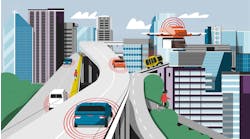Fifty years ago, a bright, shiny spacecraft delivered humans to the moon for the first time.
That breathtaking achievement captured the world’s imagination and ushered in a new era of technological innovation. Yet, at the time, largely hidden from the headlines were the countless visionaries, scientists, and builders who created the infrastructure to plan, propel, guide, land, and safely return the Apollo 11 astronauts to earth.
I’m reminded of this contrast as I witness today’s intense media focus on autonomous vehicles and, more broadly, the entire category of connected and automated vehicles (CAVs). CAVs are the bright, shiny objects of our era, potentially reshaping how we travel and integrate modes of transportation, while also influencing where we live and work. Meanwhile, much like the builders of the Saturn V rocket in the 1960s, America’s transportation agencies are working tirelessly (and often with little recognition) to answer the question: How can we create the right infrastructure to gain the optimal benefits from next-gen vehicles?
One thing is certain: People are already preparing for CAVs to take off. According to HNTB’s most recent survey, Sharing the Road with Autonomous Vehicles 2019, 58% of Americans believe that CAVs will be commonplace within the next decade.
DOTs around the country are working diligently to adapt road infrastructure for this new era, often working with academic institutions and the burgeoning number of tech companies that are innovating in this space. Here are some observations regarding both high- and lower-profile factors that are informing their efforts.
Approximately half of Americans consider themselves knowledgeable or familiar with autonomous vehicles.
OPTIMIZING FOR V2I INTEGRATION
Planners view Vehicle-to-Infrastructure (V2I) connectivity as a key driver for reducing roadway accidents and fatalities. Of particular interest is improving safety at intersections. Right now, more than half of the combined total of injury-related and fatal crashes happen at or near intersections, according to the U.S. Federal Highway Administration. Another opportunity for safety improvements is in work zones on highways and city streets, where hundreds of drivers, workers, pedestrians, and bicyclists die every year. Information-sharing between vehicles and technologies deployed in work zones could reduce collision risk as well as optimize traffic flow through these areas.
Traffic signal phase and timing (SPaT) data that is generated by traffic signals and communicated to vehicles approaching intersections offers the opportunity to harmonize traffic flow along heavily traveled corridors. “Green waves” are possible to minimize stops and reduce vehicle emissions. Traffic signal priority can be given to buses, emergency vehicles, and even trucks to support safer, more efficient movement of people and goods.
Similarly, smart curbsides at transportation hubs offer an opportunity to revolutionize access to transportation services, across different modes of transport. Such efforts clearly must be undertaken as autonomous shuttles and ride-hailing vehicles begin to arrive in greater numbers, picking up and discharging their passengers with rapid-fire efficiency. But the efficient movement of all connected vehicles can be enhanced by delivering and acting on such information as optimal pick-up points or routes to access ride-share, train or bus loading zones, projected congestion and likely idling times, and other useful data.
Two other factors also are critically relevant: cybersecurity and privacy. HNTB’s survey indicates that more than six in 10 Americans (63%) are concerned about the privacy of data generated by CAVs, and nearly as many (53%) are concerned with cybersecurity and the potential for vehicles to be “hacked.” It comes down to creating an environment of trust for consumers.
A key factor in realizing the benefits of V2I connectivity involves ensuring a dedicated communications spectrum for V2I applications. This will help to give the public greater assurance that safety messages will be reliably sent and received through secure channels.
HOW VEHICLES WILL PARK (AND NOT PARK)
Right now there are millions of parking spaces in the U.S. These spaces are typically located in downtown areas or adjacent to large commercial or entertainment facilities. As AVs proliferate, the demand for “adjacent” parking spaces will be greatly reduced. Such vehicles, after all, will enjoy the luxury of picking up and discharging their passengers all day without parking and then will retreat to distant low-demand, cheap lots where they can be recharged and maintained by their owners.
This will mean that transportation agencies that own parking lots adjacent to transit hubs may be able to repurpose some of those spaces to accommodate bicycle or scooter storage, vehicle charging, or queuing facilities. Repurposed lots can facilitate more efficient movement of traffic near the facilities (such as by adding specialized lanes for AVs, for example), or provide green space in busy activity centers. Similarly, publicly owned parking garages are likely to experience lower usage in the decades to come, which could allow agencies to raze them and either expand facilities or sell the land. Forward-looking agencies currently building new parking garages should consider design approaches that will provide maximum flexibility for potential renovations down the road. For example, building garages that have horizontal interior decks and slanted exterior ramps could allow for a less costly transformation into office or commercial space when the time is right.
PREPARING FOR DRAMATIC CHANGES IN COMMUTING BEHAVIOR
The HNTB survey also offers some interesting insights into how Americans envision a “hands-off” future as they roll down the road in an AV. Two-thirds of respondents (66%) believe they will most likely spend their time looking out the vehicle’s windows, and more than a third (42%) see themselves texting or talking during the ride. I was surprised to see that only 17% of respondents envision themselves working while traveling in an AV. I personally think this percentage will rise dramatically as workers (and their employers) seize an opportunity to transform travel time into productivity. Newfound in-motion productivity will also allow workers to live farther away from their workplaces, to reside in best-value housing options, which will rewrite the rules for traditional transportation planning and asset allocation as well as housing and commercial development strategies.
CONVERGENCE AND THE DEMAND FOR ENERGY
Also in the shadow of the CAV revolution has been the steady refinement and market acceptance of electric vehicles (EVs). We are now seeing a rapid increase in EVs coming to market, with public demand growing rapidly due to improved batteries, more rapid charging systems, and, of course, intense interest in more climate-friendly transportation. Additionally, since all AVs will also be EVs, it means that transportation agencies will have to build or facilitate the creation of both a new generation of recharging technologies and find the “juice” to make it all work.
Many EVs will be charged overnight at home, but we can anticipate significant demand for mid-trip recharging. This demand represents an opportunity for agencies to provide charging stations at existing highway service areas, rest stops, or park-and-ride areas. In the more distant future, there is also a possibility to build dynamic induction (wireless charging) systems right into the highway bed, an option that may only be practical for short sections of major highways or where freight movement by EV trucks is highly concentrated.
RE-ENVISIONING HIGHWAY DESIGN
Just as our vehicles are being re-engineered for the future of mobility, our traditional highway infrastructure must also be redesigned to support vehicles of the future. Initially, this means better pavement markings and signs that are “machine-readable” under a variety of conditions. It also may mean implementing dedicated or managed lane solutions along our highways to minimize conflicts between CAVs and other, less technologically advanced vehicles. As CAVs become more prevalent, highway agencies may be able to squeeze more capacity out of their facilities by narrowing lanes and using roadside shoulders and clear zones for multimodal travel options.
Here is another issue worth putting on our radar screens: the need to update our approaches to pavement design, materials, and construction. Automated vehicles will remain dutifully in the center of their travel lanes, which will increase stress in a narrower band of the pavement. Not only that, but on highways many connected autos and trucks will have an opportunity to “platoon,” which will generate similar stress bands and shorten the window during which pavement can recover between vehicles. These factors must be considered as we invest in roadway upgrades in the near term.
WE HAVE LIFTOFF!
The convergence of connected, automated, and electric vehicle technologies will challenge every transportation agency to innovate continuously and to form mutually beneficial partnerships with experimenters, technology firms, and sister agencies. Those of us who are crafting tomorrow’s infrastructure will never receive the same recognition as the creators of the flashy technology that will whiz down the highway. But without our concerted efforts in the next few years, nothing’s going to fly.



